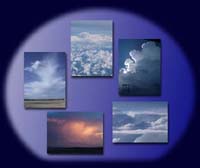Fog |
|
| Advection Fog | |
| Radiation Fog | |
| Overview | |
Advection Fog
|
Here a typical example of a low stratus cloud is shown. This
advective fog arises at the coast of San Francisco, when an air
parcel flows horizontally over a cold surface and cools down until
it reaches its dew point. Here the cooling surface is the sea
near the coast. The main wind direction changes at the north-Californian
coast around February/March, so that the winds come now from north-west.
Due to the Coriolis-force the surface water which is driven by
those winds is directed to the west. Thus cold deep-sea water
with high nutrient content is "pumped" to the surface.
This effect which endures until September is supported by trenches
in the deep-sea. Close to the coast they reach up to the surface
and thereby act like channels for the up-welling water. |
The land-sea-breeze-circulation moves the fog banks in direction
to the coast. Thereby they pass the Golden Gate Bridge (GoldenGate1.jpg
and GoldenGate2.jpg) and the coastal mountains (Mountain1.jpg
and Mountain2.jpg). For the observer it looks as if the fog flows
over mountains and valleys like water. Biological Implications The cold deep-sea water is rich of nutrients. Getting more solar radiation from June on the phytoplankton starts to "bloom". |
This results in an increase of the number density of the organisms by four orders of magnitude. This again drives a complex food chain and supports the reproduction of a lot of fish species. During this time the plants of the famous "Kelp"-forests, also known as seaweed of the type of macrocystis, grow up to 25 cm per day. Therefore the marine ecosystem in north California is characterized by a large biodiversity including sea otters, sea lions, big prawns, a variety of fishes and mussels.
|
![]()





